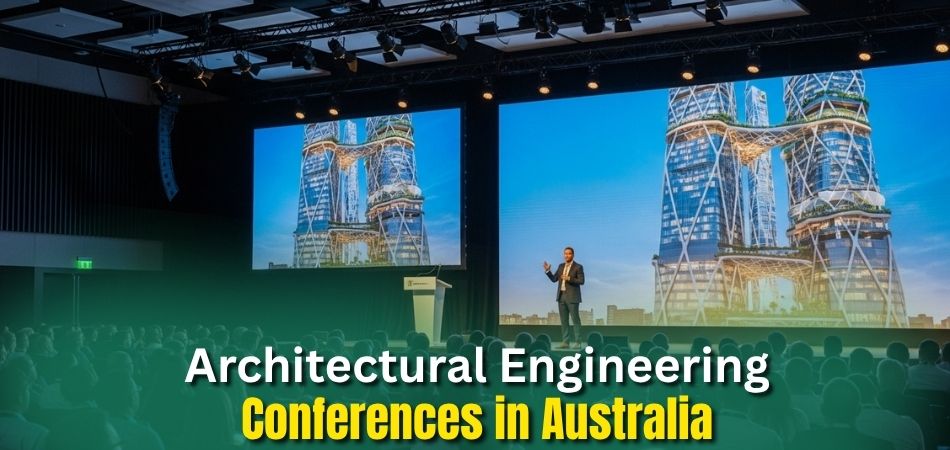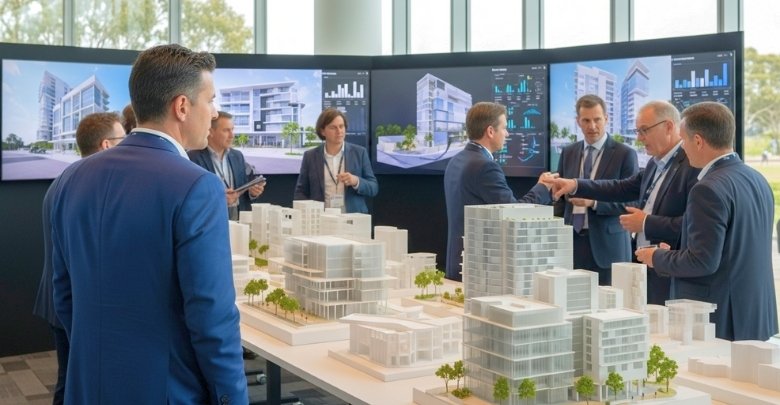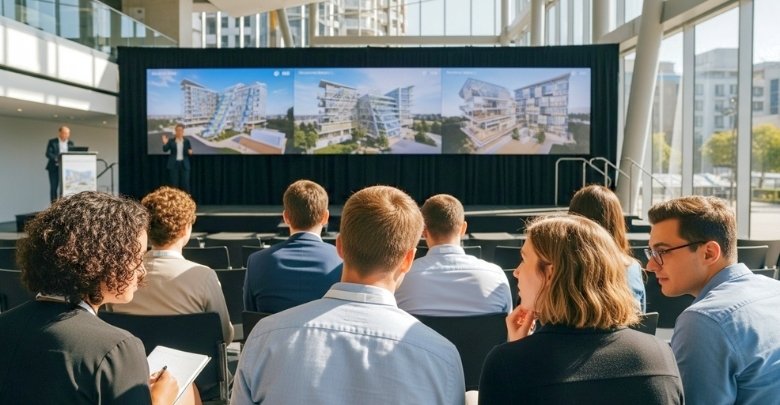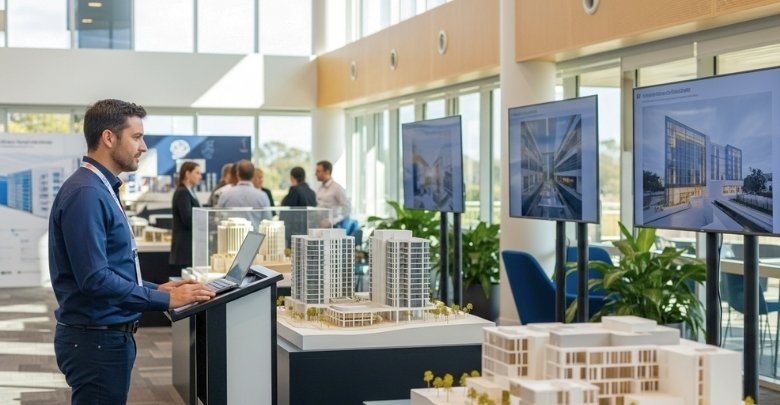Architectural engineering conferences in Australia are gaining more attention every year. They bring together bright minds, creative designs, and new ideas that shape the future of buildings and cities. If you’re someone who wants to explore what’s happening in this field, you might be thinking about the top 10 architectural engineering conferences in Australia.
Australia will host some of the biggest conferences, including the 40th Global Conference on Civil and Architectural Engineering, the AASA / ACSA International Conference, and the World Sustainable Built Environment Conference. These events will focus on architecture, civil engineering, sustainability, and innovation, bringing global experts and fresh perspectives together.
Are you interested in learning more about these important events? Keep reading, because this article shares every detail you need to know about these upcoming conferences.
Top 10 Architectural Engineering Conferences in Australia
Australia will be hosting many exciting conferences for anyone interested in architecture, civil engineering, and building design. These events bring together experts, fresh ideas, and practical solutions. Many of them highlight themes like sustainability, innovation, and future construction. If you want to know the dates and places, here’s the full list with simple details.
| Date | Conference Name | Location |
| November 14–16, 2025 | 40th Global Conference on Civil and Architectural Engineering (GCCAE) | Sydney, Australia |
| July 8–11, 2026 | 2026 AASA / ACSA International Conference | Brisbane, Queensland, Australia |
| December 3–5, 2025 | 2025 SAHANZ Conference | Launceston, Tasmania, Australia |
| November 26–28, 2025 | 4th International Conference on Structural Engineering Research | Sydney, NSW |
| June 10–12, 2026 | World Sustainable Built Environment Conference | Melbourne, Australia |
| May 19–20, 2026 | FCON26 Future of Construction Summit | Brisbane, QLD |
| November 28, 2025 | The Architecture Symposium | Clarendon Auditorium, Melbourne, Australia |
| June 11–13, 2026 | Futurebuild Australia | ICC Sydney |
| December 3–5, 2025 | ASA 2025 — 58th International Conference of the Architectural Science Association | Melbourne, Australia |
| December 3, 2025 | International Conference on Innovation in Civil, Architecture, Environment and Materials Engineering | Melbourne, Australia |
40th Global Conference on Civil and Architectural Engineering (GCCAE)
- Date: November 14-16, 2025
- Location: Sydney, Australia
Among the top civil and architectural conferences in Australia, this event brings together experts from all over the world. It focuses on modern construction techniques, safety improvements, and smart design ideas. You’ll hear from professionals who are shaping the future of cities and infrastructure. Sydney makes a perfect host for this global-level gathering.
2026 AASA / ACSA International Conference
- Date: July 8-11, 2026
- Location: Brisbane, Queensland, Australia
With the theme “Planetary Practice: Architectures of a Shared Global Future,” this event brings architects together to explore how design can help tackle global challenges. Discussions will cover sustainability, climate response, and shared responsibility. Architects from around the world will present groundbreaking research. Brisbane will host this global conversation on the future of design.
2025 SAHANZ Conference
- Date: December 3-5, 2025
- Location: Launceston, Tasmania, Australia
Unlike most conferences, this one challenges how architectural history has been told. The theme encourages looking at the past from fresh perspectives. Scholars will critique old narratives and bring new voices into historical debates. Launceston will become a hub for rethinking architecture’s roots and heritage.
4th International Conference on Structural Engineering Research
- Date: November 26-28, 2025
- Location: Sydney, NSW
Researchers and professionals in structural engineering gather here to share new findings. The event focuses on stronger, more resilient, and sustainable structures. Sessions will include architectural systems, modern methods, and eco-friendly approaches. It’s an essential event for those shaping the buildings of tomorrow.
World Sustainable Built Environment Conference
- Date: June 10-12, 2026
- Location: Melbourne, Australia
Dedicated to sustainability, this conference goes beyond the standard Sustainable Development Goals. Experts will discuss global challenges in design and construction. Attendees will hear about innovative solutions that reduce environmental impact. Melbourne will welcome leaders pushing the boundaries of green architecture.
FCON26 Future of Construction Summit
- Date: May 19-20, 2026
- Location: Brisbane, QLD
This summit looks at how new technology and digital tools are shaping the future of building. Discussions will include project management improvements and safer work practices. Industry experts will share real-life case studies and success stories. It’s a must-attend for anyone interested in modern construction.
The Architecture Symposium
- Date: November 28, 2025
- Location: Clarendon Auditorium, Melbourne, Australia
Top architects come together for a one-day symposium filled with fresh ideas, creative designs, and thoughtful discussions on modern architecture. The focus will be on new design practices, challenges, and creative ideas. Presentations are expected to inspire and spark discussion. It’s an event that blends inspiration with professional learning.
Futurebuild Australia
- Date: June 11-13, 2026
- Location: ICC Sydney
Futurebuild serves as a major platform where innovators showcase new technologies, materials, and systems shaping the future of sustainable construction. Exhibitors and experts come together to highlight sustainable and efficient construction. Sydney will host one of the largest industry gatherings here.
ASA 2025 — 58th International Conference of the Architectural Science Association
- Date: December 3-5, 2025
- Location: Melbourne, Australia
Architects and researchers gather here to explore how creativity and science come together to shape smarter, more innovative designs. It focuses on studies where creativity meets technology. Participants will learn how data and scientific methods are used in architecture. The event also provides valuable networking within the architectural science community.
International Conference on Innovation in Civil, Architecture, Environment and Materials Engineering
- Date: December 3, 2025
- Location: Melbourne, Australia
Innovation takes the spotlight in this conference covering civil, architecture, and environmental engineering. Experts will present new materials and technologies that improve performance and safety. The event will focus on how construction can be both advanced and sustainable. It is ideal for those eager to explore cutting-edge engineering ideas.
Why Australia Is Emerging as a Hub for Architectural Engineering Events
Architecture and engineering events are gaining more attention worldwide, and Australia has started standing out as one of the favorite destinations. The country offers something unique that draws experts, researchers, and students alike. Let’s take a closer look to see why.
Booming Infrastructure
Australia has seen rapid growth in infrastructure projects over the past few years. Major cities are investing in transport systems, bridges, and urban development. This growth creates more interest in architectural and engineering events. These projects also provide real-life examples for discussion and learning.
World-Class Universities
Some of the best universities for architecture and engineering are based in Australia. They attract students and professionals from all over the world. These universities often partner with conferences to share research and innovation. This connection adds more value to events held in the country.
Focus on Sustainability
Australia is paying closer attention to sustainable design and eco-friendly construction. Many conferences highlight this growing demand for green practices. Experts discuss energy-efficient buildings, renewable materials, and climate-friendly architecture. This focus makes Australia a strong destination for sustainability-driven events.
Global Connections
Conferences in Australia often bring together experts from different parts of the world. The country’s location allows it to connect Asia, Europe, and the Americas. This mix of cultures and ideas enriches every event. It helps create a more global conversation around design and engineering.
Strong Industry Support
The construction and architecture industries in Australia actively support events. Companies and professionals invest time and resources to make these gatherings successful. They see the value in sharing knowledge and building connections. This backing helps conferences grow stronger and more impactful.
Modern Facilities
Australia has some of the best venues for international conferences. From advanced auditoriums to large exhibition centers, the facilities make events smooth and professional. These modern spaces provide comfort for attendees and presenters alike. They also allow for showcasing new technology and ideas.
Attractive Destinations
The appeal of cities like Sydney, Melbourne, and Brisbane adds to the draw. Visitors not only attend the conferences but also enjoy exploring these places. The combination of professional events and vibrant destinations creates a complete experience. This makes attending events in Australia even more rewarding.
Do These Conferences Actually Lead to Career Growth?
Yes, attending these conferences can open doors to career growth in meaningful ways. They give you access to experts, mentors, and industry leaders. Meeting people face-to-face helps you build connections that often lead to future projects or job opportunities.
Conferences also keep you updated on the latest trends and practices in architecture and engineering. Learning directly from presentations and workshops adds practical knowledge you can apply in your career. Staying informed about new technologies and methods makes you more competitive in the workplace.
These events also boost confidence and motivation for many professionals. Presenting your research or ideas gives you recognition within the field. Even simply attending can inspire fresh perspectives that help you grow in both personal skills and professional success.
Trends That Keep Showing Up at Australian-based Architectural Engineering Conferences
Every year, Australia hosts conferences that bring architects and engineers together to share new ideas. These events often highlight designs that solve real problems. Many of the same themes continue to appear, showing what matters most today. Continue reading to see the most notable trends.
Modular Design
Modular design is a trend that appears again and again. It focuses on building with prefabricated parts that can be assembled quickly. This method saves time, reduces waste, and lowers costs. Many conference sessions highlight how modular design can reshape the building industry.
Disaster-resilient Buildings
Speakers often stress the need for buildings that can withstand natural disasters. Australia faces bushfires, floods, and storms, making this topic very relevant. Engineers discuss strong materials and smart structures that improve safety. These sessions remind everyone that protecting people is the top priority.
Indigenous-inspired Design
Indigenous culture and traditions play an important role in shaping architecture. Conferences highlight how designs can respect land, history, and community values. This approach brings deeper meaning to modern projects. Many experts believe it creates more thoughtful and sustainable buildings.
Smart Technology
Smart technology keeps making its way into conference talks. From sensors to automation, these tools make buildings more efficient and comfortable. Presenters often show examples of energy-saving systems and digital design tools. The focus is on blending technology with everyday life.
Green Materials
Another popular trend is the use of eco-friendly building materials. Engineers and architects are exploring wood, recycled metals, and other sustainable choices. These options reduce environmental harm while maintaining strength and beauty. Many conferences dedicate full sessions to green material research.
Urban Renewal
City growth and renewal projects come up often in Australian conferences. Speakers focus on designing better housing, transport, and public spaces. The aim is to create cities that are livable and future-ready. Urban renewal sessions often draw a lot of attention.
Energy Efficiency
Improving energy use is a recurring theme at these events. Architects present designs that cut down on power needs. Engineers share methods to integrate renewable sources like solar and wind. This focus reflects the urgent need to build for a low-energy future.
Can Students Benefit From Attending an Architectural Engineering Conference in Australia?
Yes, students can gain valuable benefits by attending an architectural engineering conference in Australia. These events offer a chance to meet professionals and peers. Listening to experts speak helps students understand real-world challenges beyond classroom lessons.
Conferences also give access to the latest research and design methods. Students can learn about sustainable practices, modular building, and innovative materials. Exposure to these ideas helps them see how classroom theory connects with professional practice.
Attending conferences can also inspire career growth. Networking with architects, engineers, and researchers may lead to mentorships or internships. Such experiences can provide students with direction, confidence, and opportunities for a strong professional start.
How to Get Involved as a Speaker, Volunteer, or Exhibitor at Architectural Engineering Conferences?
Architectural engineering conferences are more than just sessions to attend. They also open doors for people to play active roles. From sharing ideas to helping organizers or showcasing products, there are many ways to join in. Let’s look at how you can participate.
Becoming a Speaker
Speaking at a conference is a chance to share knowledge and inspire others. Most events invite applications for presentation slots months in advance. You will usually need to submit a topic, summary, and personal details. If selected, it becomes a great platform to present your ideas.
Volunteering Opportunities
Volunteering is a simple way to get involved while gaining experience. Organizers often need helpers to manage registrations, guide attendees, or assist speakers. Volunteers get behind-the-scenes access and learn how conferences really work. It also allows them to meet professionals in the field.
Exhibitor Role
Companies often join as exhibitors to showcase products or services. This involves setting up stalls where visitors can explore their work. Exhibitors gain direct contact with architects, engineers, and potential clients. It is one of the best ways to promote innovations.
Application Process
Each conference has its own application process for speakers, volunteers, and exhibitors. Information is usually available on the official website. Interested participants should check deadlines carefully and prepare their applications early. Applying on time increases the chances of being accepted.
Building Connections
Getting involved in these roles offers more than tasks or presentations. It creates opportunities to connect with industry experts. These interactions can lead to collaborations, internships, or future projects. Being active makes the whole experience more rewarding.
Tips to Make the Most of a Multi-day Conference Trip
A multi-day conference can be exciting but also overwhelming if you are not prepared. Planning ahead makes everything easier and more enjoyable. From travel to packing and attending sessions, small details make a big difference. Let’s explore simple tips that help.
Plan Early
Start by planning your trip as soon as you register for the event. Look carefully at the conference program and highlight the key sessions or workshops that interest you most. Booking transport and hotels in advance not only saves money but also gives you more options. A clear plan means you will avoid rushing around and can focus on enjoying and learning from the conference.
Arrive a Day Before
Reaching a day early gives you time to rest and settle in. Travel delays or last-minute issues won’t affect your schedule or cause unnecessary stress. Use the extra time to explore the venue, register, and get familiar with the surroundings. Arriving fresh and relaxed ensures you are ready to participate actively from the very first session.
Pack Smart
Packing only what you need makes travel smoother and lighter. Bring clothes suited for both professional sessions and comfortable downtime after the event. Essentials like chargers, notebooks, pens, and business cards are easy to overlook but very important. Keeping your luggage simple means you can move around more freely and avoid the stress of managing too many items.
Schedule Wisely
Check the event timetable and choose your must-attend sessions, keynotes, or workshops. It’s usually impossible to attend everything, so focus on the sessions most useful to you. Also, leave some breaks for meals, rest, and unplanned networking. A flexible but balanced schedule keeps you energized and ensures you enjoy each day without feeling overwhelmed.
Take Notes
Always keep a notebook or digital app handy during talks and discussions. Writing down key points helps you remember important ideas for later. Quick notes after each session make the information clearer and easier to review. Notes can also be shared with colleagues or friends who couldn’t attend, making them even more valuable.
Network Naturally
Conferences are just as much about people as they are about sessions. Take time to introduce yourself to fellow attendees, speakers, or exhibitors. Casual conversations often lead to lasting professional connections and even friendships. Networking works best when it feels natural and relaxed, so don’t be afraid to start small conversations.
Stay Healthy
Eating well and sleeping enough are very important during multi-day events. Long days with back-to-back sessions can feel exhausting if you don’t take care of yourself. Carry healthy snacks, drink water often, and avoid too much caffeine. Taking care of your body helps you stay focused, energized, and ready to learn throughout the entire event.
Explore the City
If the conference is in another city, try to spare some time to explore local attractions. Visiting landmarks, parks, or food spots makes the trip feel more rewarding. It also gives you a refreshing break from long hours inside conference halls. Blending learning with leisure adds balance and makes the whole trip more memorable.
Commonly Asked Questions
Attending architectural engineering conferences in Australia can raise many practical questions. From registration details to networking tips, people often wonder how to prepare, what to expect, and how to make the most of these events. Here are some of the most asked questions answered for you.
How Can I Register for Architectural Engineering Conferences in Australia?
Most conferences in Australia have online registration through their official websites. Registration usually opens months in advance and offers early bird discounts. You’ll need to fill out basic details, select your ticket type, and complete payment. Always check deadlines early to secure your spot.
What Is the Usual Cost to Attend?
Conference costs vary depending on the type of ticket and the event. Student tickets are often cheaper, while professional or corporate passes can be higher. Some conferences include meals, workshops, and materials, while others may charge separately. Checking in advance helps you plan your budget.
Are Online Attendance Options Available?
Many conferences now offer hybrid models with both in-person and virtual attendance. Virtual tickets usually include live-streamed sessions, recordings, and Q&A participation. This makes it easier for people who cannot travel to still benefit. Each conference website provides details about online participation.
Do Conferences on Architectural Engineering Offer Certificates?
Yes, many conferences provide certificates of participation or completion. These certificates can be useful for resumes, portfolios, or academic recognition. Some events also issue professional development hours that count toward industry requirements. It’s best to confirm this before registering.
What Should I Wear to These Conferences?
Dress codes for architectural conferences are usually smart casual or business casual. Some events may require formal wear for networking dinners. Comfortable shoes are useful, especially for events with exhibitions or multiple halls. Always balance professionalism with comfort.
Are These Conferences Open to the Public?
Most conferences require prior registration and are not open to walk-ins. Some events may have open exhibitions where the public can visit freely. Professional sessions, however, usually require tickets. Checking the event’s website helps you understand which parts are public-friendly.
Is There a Dress Code for Attending These Events?
There’s no strict dress code, but most people dress in business casual or professional attire. Since you’ll be meeting experts and networking, it’s best to dress neatly. Comfortable shoes are a smart choice for moving around venues. A clean and tidy appearance always helps make a good impression.
Can International Visitors Attend These Conferences?
Yes, international visitors are welcome at most Australian conferences. Many events even attract speakers and attendees from around the world. You’ll just need to arrange your visa and travel documents early. It’s a great way to meet global experts and explore Australia at the same time.
Conclusion
Australia is quickly becoming a favorite spot for bold ideas, fresh designs, and inspiring engineering discussions. With beautiful host cities and strong industry support, these events are drawing more attention every year. Whether you’re new or experienced, you’ll find something valuable.
Attending the top 10 architectural engineering conferences in Australia means more than just listening to talks. These gatherings bring practical knowledge, networking opportunities, and a closer look at real-world challenges. Each event has its own way of shaping personal and professional growth.
If you’re planning to join as a visitor, speaker, or even an exhibitor, now is the right time to prepare. These conferences can spark creativity, open career doors, and connect you with people who are shaping the future of design.









